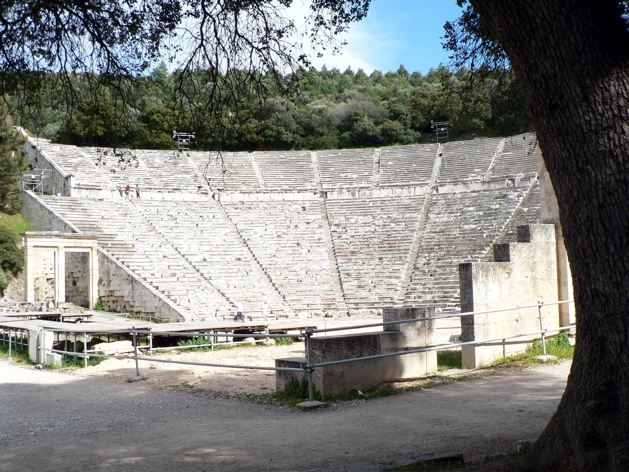<--Previous Up Next-->

P1060977.JPG
Epidaurus, Greece: theatre for music & poetry contests
We had a super lunch on board our ship. Wonderful Greek salads and a super spinach and rice dish.
After lunch we drove east from Nafplios to Epidouros, which is drier and full of olive trees. There isn’t enough water for orange trees.
There is a fortress from the 3rd c BC which guarded the route to the tomb of Aesclepius, so of Apollo, who is credited starting the first hospitals. The story is that Apollo performed a Caesarian on a woman who was dying, and raised her son as his own, and had him trained by Chiron, a surgeon in his own right, from whom he learned all about herbs and surgical techniques. He set up a series of residences where knowledge of medicine could accumulate and where the sick could come to be cured. Those residences were called Aesclepius, after their founder. Hippocrates worked in the Aesclepius of Knossos.
Æsclepius (also spelt: Asclepios, Æsclepius, Æsculapius, Æsclepius) was a healer, his mythical roots going back in to the second millennium BC, he became a demi-god. Over time he evolved into a temple god in his own right. The temples in his honor were temples of healing dreams. His daughters were Hygea (on the preventive side of medicine) and Panacea (on the drug side of medicine). A Klínè was a sacred place or a sacred skin set out around the temple, where the sick person reclined to enter the dream state. From these names we have derived the words, Panacea, Hygiene and Clinic. At the height of the cults power, there were 420 temples, spread across the ancient Greek empire.
The Aesclepiae were devoted to diet, exercise, study, and spa bathing. In the days of Hippocrates the Aesclepiae performed no operations except childbirth and simple orthopedics. They might also remove little surface tumors or thrombosis relief. After the death of Alexander the Great, the Aesclepiae could dissect bodies and perform operations. The then found out how body muscles and bones worked. They did not learn about the blood circulation. In Western Europe medical care stops with the fall of the Roman Empire, and doesn’t revive until the 8th c AD when the Arabs attack Spain. The Knights of St. John took up the practice of medicine. In Greece the practice of medicine continued throughout because there was still a central authority.
In the 3rd c AD, Goths completely destroyed the sanctuary at Nafplion. The only building remaining was the theatre of. Epidauros. Every 3-4 years the theatre of Epidauros would have a festival with athletic, singing, and poetry contests.
